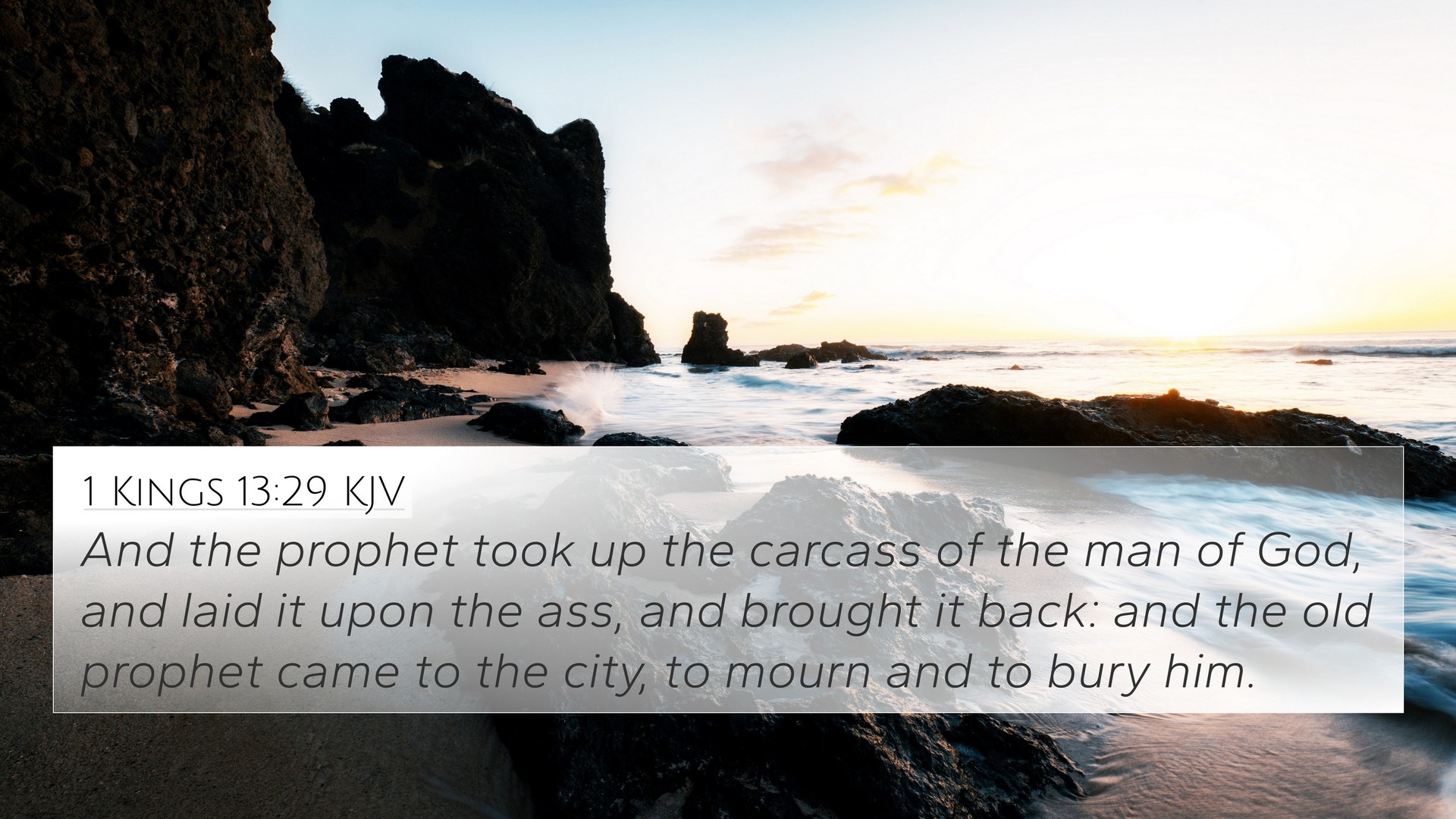Understanding 1 Kings 13:29
This passage from 1 Kings 13:29 reads:
"And the prophet took up the carcass of the man of God, and laid it upon the ass, and brought it back: and the old prophet came to the city, to mourn and to bury him."
Meaning and Interpretation of 1 Kings 13:29
This verse is a poignant closure to the story of the man of God from Judah, who was sent to prophesy against the altar at Bethel but met with tragic consequences due to disobedience to God's command.
Key Insights from Commentaries
-
Matthew Henry's Commentary:
Henry emphasizes the contrast between the faithful obedience of the man of God and the deceit of the old prophet. The return of the body signifies the gravity of the situation and the old prophet's remorse.
-
Albert Barnes' Notes:
Barnes notes the significance of the burial and mourning process, highlighting the importance of honoring the dead, even those who have faltered. It shows the recognition of the prophet’s previous faithfulness against the backdrop of his tragic failure.
-
Adam Clarke's Commentary:
Clarke reflects on the broader implications of this story, pointing out that it serves as a warning about the dangers of false guidance and emphasizes the dire consequences of not adhering strictly to God’s commands.
Applications and Lessons
This passage invites readers to reflect upon:
- Obedience to God's voice.
- The influence of others in our spiritual journey.
- The importance of accountability and consequences for actions.
Cross-References for 1 Kings 13:29
In studying this verse, several biblical verses can be cross-referenced to create a more comprehensive understanding:
- 1 Kings 13:1-3: The initial prophecy against the altar, indicating the man of God's original mission.
- 1 Kings 13:15-19: The encounter with the old prophet, which unveils the deception that led to the man's downfall.
- Jeremiah 23:16: Warning about false prophets and their deceitful counsel.
- Matthew 7:15: A New Testament reminder regarding the nature of false prophets.
- Galatians 1:6-9: A reminder that deviating from the Gospel can have fatal spiritual consequences.
- Hebrews 10:31: The fear of falling into the hands of the living God if one persists in disobedience.
- 2 Peter 2:1: Insight into the presence of false teachers within the community of believers.
Connections and Thematic Analysis
The thematic connections between these verses point towards the importance of adherence to God's revelation and awareness of the impact of external influences on an individual's faith journey. The interplay of obedience, deception, and consequence echoes throughout the scriptures, offering a comprehensive framework for understanding spiritual fidelity.
Comparative Bible Verse Analysis
When we engage in comparative Bible verse analysis, we enhance our understanding of the interconnectedness of scripture. This verse not only reflects on the fate of the man of God but also serves as an essential reminder of the biblical themes prevalent throughout both the Old and New Testaments.
Related Themes
Examining these themes can provide deeper insights into:
- How to find cross-references in the Bible: Utilize a Bible concordance for effective cross-referencing.
- Identifying connections between Old and New Testament: Look for parallels in teachings regarding prophets and God's word.
- Bible verses related to prophecy and guidance: Understanding the role of prophecy as a divine directive.
- Cross-referencing Psalms with New Testament teachings: Investigating the theme of obedience and worship across scripture.
Conclusion
In summary, 1 Kings 13:29 encourages us to delve deeply into Bible verses that relate to each other and to study the connections between Bible verses. Through diligent study and scriptural cross-referencing, we can grasp the profound messages God communicates to us about faith, obedience, and the importance of discerning true guidance amidst the multitude of voices in our spiritual lives.


